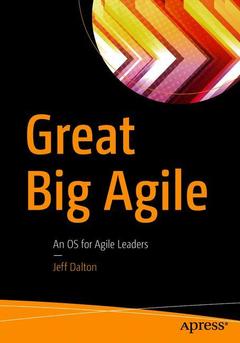Great Big Agile, 1st ed. An OS for Agile Leaders
Auteur : Dalton Jeff

As more companies seek the benefits of Agile within and beyond IT, agile leaders need to build and sustain capability while scaling agility?no easy task?and they need to succeed without introducing unnecessary process and overhead. The APH is drawn from lessons learned while observing and assessing hundreds of agile companies and teams.
It is not a process or a hierarchy, but a holarchy, a series of performance circles with embedded and interdependent holons that reflect the behaviors of high-performing agile organizations. Great Big Agile provides implementation guidance in the areas of leadership, values, teaming, visioning, governing, building, supporting, and engaging within an all-agile organization.
What You?ll Learn
- Model the behaviors of a high-performance agile organization
- Benefit from lessons learned by other organizations that have succeeded with Big Agile
- Assess your level of agility with the Agile Performance Holarchy
- Apply the APH model to your business
- Understand the APH performance circles, holons, objectives, and actions
- Obtain certification for your company, organization, or agency
Who This Book Is For
Professionals leading, or seeking to lead, an agile organization who wish to use an innovative model to raise their organization's agile performance from one level to the next, all the way to mastery
Part 1: The Agile Performance Holarchy.-
Chapter 1: The API Is Broken.-
Part 2: The Performance Circles.-
Chapter 2: Performance Circle: Leading.-
Chapter 3: Performance Circle: Providing.-
Chapter 4: Performance Circle: Envisioning.-
Chapter 5: Performance Circle: Crafting.-
Chapter 6: Performance Circle: Affirming.-
Chapter 7: Performance Circle: Teaming.-
Part 3: Ceremonies and Techniques.-
Chapter 8: Acceptance Testing.-
Chapter 9: Agile Agreement.-
Chapter 10: Agile Digs.-
Chapter 11: Agile Partner Assessment.-
Chapter 12: All Hands Raised.-
Chapter 13: Arc of Conversation.-
Chapter 14: Automated Build.-
Chapter 15: Backlog Grooming.-
Chapter 16: Best Practices Board.-
Chapter 17: Big Room Planning / Release Zero.-
Chapter 18: Brainstorming.-
Chapter 19: Burn Down Chart.-
Chapter 20: Confirmation.-
Chapter 21: Continuous Deployment.-
Chapter 22: Continuous Integration.-
Chapter 23: Class, Responsibilities, Collaborators (CRC) Cards.-
Chapter 24: Daily Stand-Up.-Chapter 25: Definition of Done.-
Chapter 26: Definition of Ready.-
Chapter 27: Dot Voting.-
Chapter 28: Epics.-
Chapter 29: Evaluation.-
Chapter 30: Frequent Releases.-
Chapter 31: Gemba Walks.-
Chapter 32: Gemba Kaizen.-
Chapter 33: Goal, Question, Metric (GQM).-
Chapter 34: Incremental Development.-
Chapter 35: Kamishibai (Board and Cards).-
Chapter 36: Kanban Board.-
Chapter 37: Kano Model.-
Chapter 38: Lean Coffee.-
Chapter 39: Mob Programming.-Chapter 40: Obeya Room.-
Chapter 41: Open Space Technology.-
Chapter 42: Pair Programming.-
Chapter 43: Peer Reviews.-
Chapter 44: Planning Poker.-
Chapter 45: Product Backlogs.-
Chapter 46: Product Scenarios.-
Chapter 47: Project (Team) Chartering.-
Chapter 48: Prototyping/Spike.-
Chapter 49: Release Planning.-
Chapter 50: Retrospectives.-
Chapter 51: Review.-
Chapter 52: Roles and Accountabilities Game.-
Chapter 53: Scrum of Scrums.-
Chapter 54: Scrum Wall / Scrum Board.-
Chapter 55: Self-Selection/Self-Subscription.-
Chapter 56: Spike (Design Spike).-
Chapter 57: Sprint.-
Chapter 58: Sprint Demo.-
Chapter 59: Sprint Planning.-
Chapter 60: Stakeholder Identification and Management.-
Chapter 61: State of the Team.-
Chapter 62: SWOT Analysis (Strengths, Weaknesses, Opportunities, Threats).-
Chapter 63: Team Agreement.-
Chapter 64: Team Estimation Game.-
Chapter 65: Team Room Set-Up.-
Chapter 66: Technical Debt.-
Chapter 67: Test-Driven Development.-Chapter 68: Three Diverse Humans.-
Chapter 69: Training.-
Chapter 70: Unit Testing.-
Chapter 71: Velocity.-
Chapter 72: Visual Information Management.-
Part 4: Next Steps for Leaders.-
Chapter 73: Using the Agile Performance Holarchy.-
Appendix A: Quick Reference Tables.-
Glossary.-
Jeff Dalton thinks the future of Big Agile is our industry’s biggest challenge, and he has been studying it for years. As the large adopters in the federal government and corporate sector begin to adopt agile, they will bring their habits, culture, and bureaucracies with them, and in dozens of podcasts, articles, books, and keynote speeches Jeff has been talking about getting in front of the wave. A veteran technologist and IT leader, Jeff started as a software developer and has been a CEO, chief technology executive, vice president of product development, director of quality, and Agile evangelist for over 30 years, including time with Ernst and Young, Electronic Data Systems, Hewlett Packard, Intellicorp, Polk, Broadsword, and AgileCxO. As a consultant, teacher, CMMI lead appraiser, and leadership coach, he has worked with NASA, Boeing, Accenture, Bose, L3 Communications, Fiat Chrysler Automotive, General Motors, Ford, and various federal and state agencies to help them improve performance. Jeff is a frequent keynote speaker, Agile performance holarchy assessor, blogger, and host of The Agile Leadership Podcast, a monthly series that interviews CIOs from state government about the challenges of agile adoption. In his spare time he is an instrument-rated pilot and plays bass in a jazz band.
Provides organizational and behavioral guidelines for scalable and sustainable agility
Shows you how to build agile capability with an objective model based on the CMMI, Agile frameworks, and independent research
Teaches you how self-organization can bring a greater level of agile capability
Date de parution : 12-2018
Ouvrage de 335 p.
17.8x25.4 cm
Thème de Great Big Agile :
Mots-clés :
Agile; Agile solutions; Agility; Holarchy; Agile performance holarchy; APH; Performance; Holons; Performance circles; CMMI; Leadership; Teaming; Visioning; Jeff Dalton



